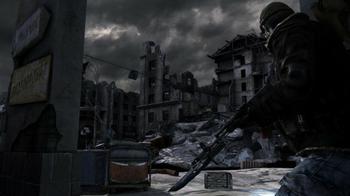What's lurking in the dark?
The environment in Metro 2033 is well designed. Blood spatters, rusting rail carriages, and unstable surfaces litter the tunnels. Platforms and ladders can give way with only a few seconds of warning. Wire traps, broken glass and dangling cans are strategically placed to give the human enemies notice of your presence. Electric lights and gas lamps can be turned off, which can be a real advantage to those wishing to utilise a more stealthy strategy (something facilitated by night vision goggles!). Often, this kind of approach can pay off - it can be easier to sneak round certain enemies and save ammunition rather than going in guns blazing. When the faster tunnel dwelling beasts charge at you, you will be glad of the extra bullets.Metro 2033 is perhaps not quite as perfect as you may have concluded by now. It is unfortunately let down by a few points, chief among which is the game's apparent problems with it's graphics engine. At several times throughout the game, it would crash to desktop, often when there were several large explosions at once.
The AI can be a little illogical at times. At one point, a guard could see Artyom through a large swathe of dark tunnel, with no torch and no NVGs. At another, a soldier with identical equipment did not notice Artyom crouching directly beside him. The introduction of PhysX has been poorly implemented too. Items such as chairs and wooden slats often ping about a room as if caught in a explosion after Artyom has brushed by them.

The damage system is also flawed. On some occasions, a human enemy could take several rounds to the chest and head and still be standing. On others, it would only take a single shot to the head to kill. However, these are all only small errors, and can mostly likely be patched out of the game in future updates or driver releases. They are far from game breaking and should not get in the way of you enjoying this atmospheric shooter.
Score: 85%
PC specs can be found overleaf.
Read the offical HEXUS.gaming review: here.


